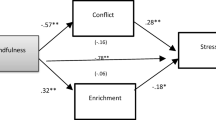Abstract
Using structural equation modeling the relationship of work stress and marital cohesion was empirically investigated. It was hypothesized that work stress would have an inverse relationship with marital cohesion. Participants were a random sample of 326 adult females who were members of the American Counseling Association. The results of the data-model fit analyses support the hypothesized relationship. The coefficient of determination for the structural equation was 0.60 indicating a substantial degree of explanation for the relationship tested. Implications of these findings for future research are presented.
Similar content being viewed by others
REFERENCES
Bollen, K. A. (1989). Structural equation with latent variables. New York: Wiley.
Carroll, J. J., & Robinson, B. E. (2000). Parentification and depression among adult children of workaholics and adult children of alcoholics. The Family Journal, 8, 360-367.
Chou, C. P., & Bentler, P. M. (1995). Estimates and tests in structural equation modeling. In R.H. Hoyle (Ed.), Structural Equation Modeling: Concepts, issues, and applications (pp. 37-55). Thousand Oaks, CA: Sage.
Flowers, C. P., Robinson, B. E., & Carroll, J. J. (2000). Criterion-related validity of the Marital Disaffection Scale as a measure of marital estrangement. Psychological Reports, 86, 1101-1103.
Gabbard, G. O., & Menninger, R. W. (1989). The psychology of postponement in the medical marriage. The Journal of the American Medical Association, 261, 2378-2381.
Haymon, S. (1993). The relationship of work addiction and depression, anxiety, and anger in college males (Doctoral dissertation, Florida State University, 1992). Dissertation Abstracts International, 53. 5401-B.
Kayser, K. (1996). The Marital Disaffection Scale: An inventory for assessing emotional estrangement in marriage. The American Journal of Family Therapy, 24, 83-88.
Kersten, K. K. (1990). The process of martial disaffection: Interventions at various stages. Family Relations, 39, 257-265.
Jöreskog, K. J., & Sörbom, D. (1999). LISREL 8: User's reference guide. Chicago: Scientific Software.
Matthews, L. S., Conger, R. D., & Wickrama, K. A. S. (1996). Work-family conflict and marital quality: Mediating processes. Social Psychology Quarterly, 59, 62-79.
Navarrette, S. (1998). An empirical study of adult children of workaholics: Psychological functioning and intergenerational transmission. Unpublished doctoral dissertation. California Graduate Institute.
Oates, W. E. (1968). On being a “workaholic” (A serious jest). Pastoral Psychology, 19, 16-20.
O'Leary, K. D., & Arias, I. (1983). The influence of marital therapy on sexual satisfaction. Journal of Sexual and Marital Therapy, 9, 172-181.
O'Leary, K. D., Fincham, F., & Turkewitz, H. (1983). Assessment of positive feelings toward spouse. Journal of Consulting and Clinical Psychology, 51, 949-951.
Orbuch, T. L., House, J. S., Mero, R. P., & Webster, P. S. (1996). Marital quality over the life span. Social Psychology Quarterly, 59, 162-171.
Pietropinto, A. (1986). The workaholic spouse. Medical Aspects of Human Sexuality, 20, 89-96.
Robinson, B. E. (1996). Concurrent validity of the Work Addiction Risk Test as a measure of workaholism. Psychological Reports, 79, 1313-1314.
Robinson, B. E. (1998a). Chained to the desk: A guidebook for workaholics, their partners and children, and the clinicians who treat them. New York: New York University Press.
Robinson, B. E. (1998b). Spouses of workaholics: Clinical implications for psychotherapy. Psychotherapy, 35, 260-268.
Robinson, B. E. (1998c). The workaholic family: A clinical perspective. The American Journal of Family Therapy, 26, 63-73.
Robinson, B. E. (1999a). The Work Addiction Risk Test: Development of a tentative measure of workaholism. Perceptual and Motor Skills, 88, 199-210.
Robinson, B. E. (1999b). Workaholic children: One method of fulfilling the parentification role. In N. Chase (Ed.), Burden children: Theory, research, and treatment of parentification (pp. 56-74). Thousand Oaks, CA: Sage.
Robinson, B., Carroll, J. J., & Flowers, C. (in press). Marital estrangement, positive affect, and locus of control among spouses of workaholics and spouses of non-workaholics: A national study. American Journal of Family Therapy.
Robinson, B. E., & Chase, N. (2001). High-performing families: Causes, consequences, and clinical solutions. Washington, DC: American Counseling Association.
Robinson, B. E., & Kelley, L. (1998). Adult children of workaholics: Self-concept, locus of control, anxiety, and depression. The American Journal of Family Therapy, 26, 223-238.
Robinson, B. E., & Phillips, B. (1995). Measuring workaholism: Content validity of the Work Addiction Risk Test. Psychological Reports, 77, 657-658.
Robinson, B. E., & Post, P. (1994). Validity of the Work Addiction Risk Test. Perceptual and Motor Skills, 78, 337-338.
Robinson, B. E., & Post, P. (1995a). Split-half reliability of the Work Addiction Risk Test: Development of a measure of workaholism. Psychological Reports, 76, 1226.
Robinson, B. E., & Post, P. (1995b). Work addiction as a function of family of origin and its influence on current family functioning. The Family Journal, 3, 200-206.
Robinson, B. E., & Post, P. (1997). Risk of addiction to work and family functioning. Psychological Reports, 81, 91-95.
Robinson, B. E., Post, P., & Khakee, J. F. (1992). Test-retest reliability of the Work Addiction Risk Test. Perceptual and Motor Skills, 74, 926.
Searey, E. A. (2000). Adult children of workaholics: Anxiety, depression, family relationships, and risk for work addiction. Unpublished masters' thesis, University of South Australia.
Snyder, D. K., & Regts, J. M. (1982). Factor scales for assessing marital disharmony and disaffection. Journal of Consulting and Clinical Psychology, 50, 736-743.
Spence, J. T., & Robbins, A. S. (1992). Workaholics: Definition, measurement, and preliminary results. Journal of Personality Assessment, 58, 160-178.
Weeks, D. (1995). Cooling off your office affair. Northwest Airlines World Traveler Magazine, 59-62.
West, S. G., Finch, J. F., & Curran, P. J. (1995). Structural equation models with nonnormal variables. In R. H. Hoyle(Ed.), Structural Equation Modeling: Concepts, issues, and applications (pp. 56-75). Thousand Oaks, CA: Sage.
Author information
Authors and Affiliations
Rights and permissions
About this article
Cite this article
Robinson, B.E., Flowers, C. & Carroll, J. Work Stress and Marriage: A Theoretical Model Examining the Relationship Between Workaholism and Marital Cohesion. International Journal of Stress Management 8, 165–175 (2001). https://doi.org/10.1023/A:1009533415030
Issue Date:
DOI: https://doi.org/10.1023/A:1009533415030




